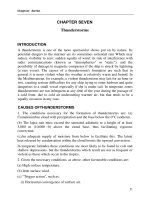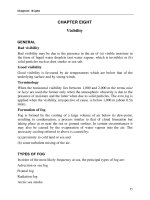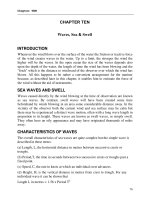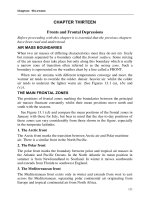BÀI GIẢNG KHÍ TƯỢNG LÝ THUYẾT CHƯƠNG 13
Bạn đang xem bản rút gọn của tài liệu. Xem và tải ngay bản đầy đủ của tài liệu tại đây (356.58 KB, 16 trang )
Chapter Thirteen
CHAPTER THIRTEEN
Fronts and Frontal Depressions
Before proceeding with this chapter it is essential that the previous chapters
have been read and understood.
AIR MASS BOUNDARIES
When two air masses of differing characteristics meet they do not mix freely
but remain separated by a boundary called the frontal surface. Some mixing
of the air masses does take place but only along this boundary which is really
a narrow zone of transition often referred to as the mixing zone. Such a
boundary is represented on the weather chart by a line called a FRONT.
When two air streams with different temperatures converge and meet. the
warmer air tends to override the colder. denser. heavier air. whilst the colder
air tends to undercut the lighter warm air. (See Figures 13.1 (a), (b) and
(c)).
THE MAIN FRONTAL ZONES
The positions of frontal zones marking the boundaries between the principal
air masses fluctuate constantly whilst their mean positions move north and
south with the seasons.
See Figure 13.1 (d) and compare the mean positions of the frontal zones in
January with those for July, but bear in mind that the day-to-day positions of
these zones can vary considerably from those shown in the figure. especially
in the temperate latitudes.
1. The Arctic front
The Arctic front marks the transition between Arctic air and Polar maritime
air. There is a similar front in the North Pacific.
2. The Polar front
The polar front marks the boundary between polar and tropical air masses in
the Atlantic and Pacific Oceans. In the North Atlantic its mean position in
summer is from Newfoundland to Scotland. In winter it moves southwards
and extends from Florida to southwest England.
3. The Mediterranean front
The Mediterranean front exists only in winter and extends from west to east
across the Mediterranean. separating polar continental air originating from
Europe and tropical continental air from North Africa.
111
Chapter Thirteen
112
Chapter Thirteen
113
Chapter Thirteen
4. The intertropical convergence zone (I.T. C.Z.)
The intertropical convergence zone lies within the tropics and is a broad zone
of separation between the N.E. and S.E. Trades which flow equatorwards
from opposite hemispheres. It was formerly known as the Intertropical Front
but this term has fallen into disuse, because the opposing air masses do not
differ greatly in their characteristics and it bears little resemblance to other
fronts.
The I.T.C.Z. crosses and recrosses the equator at several point's and moves
well north in the summer. Due to the very large land masses in the northern
hemisphere [he greater part of its length (in its mean position) lies north of the
equator. Its range of movement is small over the oceans but may be very large
over the continents. Areas of horizontal convergence along this belt vary from
day to day in both position and activity but are generally associated with
cloudy showery weather. See Figure 13.1 (d).
FRONTAL THEORY OF FORMATION OF DEPRESSIONS
Within the temperate zones cold air flowing from high latitudes encounters
warm air moving from sub-tropical regions. The two air masses are separated
by a frontal surface which slopes upward over the colder denser air at a
gradient which varies from 1 in 40 to 1 in 200. (See Figures 13.1 (a), (b) and
(c)).
The polar front tends to remain inactive so long as the warm and cold air
masses flow parallel to one another but when they converge warm moist air is
forced upwards over the cold frontal surface. This can result in the formation
of much cloud and precipitation and often starts the mechanism which leads
to the formation and development of a frontal depression. The sequence of
events is described in the following paragraphs:
Under suitable conditions a small wave forms on the polar front, so that at
this point there is a bulge of warm air protruding into the cold. See Figure
13.2 and note that the two air masses flow more or less parallel to one another
along the polar front. except at the bulge where the winds are convergent.
(See Convergence in Appendix 1).
The wave continues to grow in size. Development usually follows and
pressure falls at the crest of the wave.
Enlargement of the bulge continues and this is accompanied by a further fall
in pressure. The isobars then assume the closed form of a depression and the
wind circulates round the tip of the bulge. As pressure continues to fall the
114
Chapter Thirteen
gradient becomes steeper and the winds stronger. (See Figure 13.3).
Figure 13.3 shows the isobars and fronts of a well developed and active
depression. The line LX is a warm front, since warm air is replacing cold air
along this line. LY is a cold front since cold air is replacing warm air along
this line. The warm and cold fronts are represented on the weather chart by
the symbols shown in Figure 13.3. On working charts warm and cold fronts
are represented by red and blue lines respectively.
The area between LX and LY is known as the "warm sector" of the
depression.
The centre of the depression will move along the polar front in a direction
roughly parallel to the isobars in the warm sector and at a speed
approximating to that of the air in the warm sector. (See Figure f3.3).
115
Chapter Thirteen
116
Chapter Thirteen
117
Chapter Thirteen
118
Chapter Thirteen
119
Chapter Thirteen
THE OCCLUDING OF A DEPRESSION
The cold front advances faster than the warm front and gradually overtakes it,
commencing at the tip of the warm sector and working down the length of the front
until the occluding process has been completed and all the tropical air has been
lifted off the ground. Figures 13.6 and 13.7 show the stages in the occluding
process. Note that the symbol for an occlusion is a combination of those used for
warm and cold fronts. On working charts an occlusion is represented by a purple
line.
An occlusion is classified as warm or cold according to whether the overtaking
polar air is warmer or colder than the retreating polar air. respectively. In the
former case the overtaking air will override the colder air and, in the latter case,
will undercut the warmer air. (See Figures 13.8 (a) and (b), 13.9 (a) and (b)).
In Figures 13.8(a) and 13.9(a) the position of the upper front is indicated by a
dotted line. Compare these two figures and notice that the line marking a cold
occlusion is continuous with the line of the cold front whereas the warm occlusion
is shown as a continuation of the warm front.
MATURITY AND DISSOLUTION OF A DEPRESSION
The energy to develop and sustain an active frontal depression is derived mainly
from the supply of air in the warm sector. Thus a depression having a wide warm
sector will usually continue to deepen and grow in size whilst unoccluded, and
often during the early stages of occlusion. Later this development ceases and the
speed and direction of movement of the centre is no longer related to that of the air
in the warm sector, instead it becomes dependent on the general flow of air over a
wide area. Movement tends to become slow at this stage and the depression may
120
Chapter Thirteen
take several days to fill up, but the process of weakening is likely to be more rapid
over a surface which is relatively cold.
The arrival of a new, more vigorous system can destroy the old circulation and
cause it to fill up within 24 hours.
MOVEMENT OF DEPRESSIONS
(a) Small active depressions move faster than large dying ones.
(b) Small depressions tend to follow the flow of isobars in the general pattern-Le to
follow the main stream.
(c) All depressions move from areas of rising pressure tendency towards areas of
falling pressure tendency-i.e. from isallobaric high to isallobaric low. (See
pressure tendency and isallobar in Appendix 1). If barometric tendencies are the
same all round the centre of a depression it will remain stationary.
(d) Depressions tend to follow the flow of air round the perimeter of large, well
established. warm anticyclones.
(e) An unoccluded depression moves in a direction parallel to the isobars in the
warm sector and, at sea, at approximately the same speed as the surface wind in the
warm sector.
(f) A partly occluded depression tends to slow down as the occluding process
continues.
(g) A fully occluded depression becomes slow and sometimes erratic in movement,
but generally moving in the direction of the average flow of air up to the
tropopause. It also tends to move off to the left of its original track in the northern
hemisphere and to the right in the southern hemisphere. Large completely occluded
depressions are liable to become stationary. or nearly so. especially if there is little
horizontal change in temperature within the area covered.
(h) A depression within a family (see Fig 13.10) follows the approximate path of
its parent but tends to move • off" towards lower latitudes.
(i) Secondary depressions tend to move with the main circulation of air round the
primary.
(j) A non-frontal depression tends to move in the same direction as the strongest
winds circulating round it.
121
Chapter Thirteen
122
Chapter Thirteen
123
Chapter Thirteen
THE FUTURE MOVEMENT OF A DEPRESSION
This can be estimated by "extrapolation". That is, movement can be assumed to
continue as shown by a succession of synoptic charts: but other factors should be
taken into consideration. e.g .. (a) to (j) above.
A "FAMILY" OF DEPRESSIONS
The speed of movement of a cold front is greatest where the winds are strongest,
that is, near the depression's centre. Near the perimeter of the system movement is
less rapid and, as the whole system advances, the cold front tends to trail out well
to the rear where it is continuous with the more or less inactive part of the polar
front. A new depression may be formed on this trailing cold front and. as it matures
and occludes. the process is repeated and another depression is born. 10 this way a
family of three, four or five depressions may be formed, each new one on the
trailing cold front of its parent. (See Fig 13.10).
The cold air circulating in the rear of each system pushes the polar front further
towards the sub-tropics; thus the track of each depression in the family commences
in a lower latitude than that of its parent. Finally the cold air breaks through the
polar front and flows equatorwards to feed the trade winds. Meanwhile an
anticyclone builds up in the polar air, a new family commences to form on its
poleward side and the whole cycle may be repeated.
A family of depressions approaching the British Isles from the Atlantic will give a
period of very unsettled weather. The high pressure ridges between the lows will
generally give short-lived periods of fine weather.
124
Chapter Thirteen
FORMATION OF SECONDARY DEPRESSIONS
A secondary depression is one which is contained within the circulation of a larger
depression called the primary. The depression forming on the trailing cold front of
a depression is an example of a secondary depression (See Fig 13.10).
Occasionally depressions can also form at the tip of the warm sector or on the
warm front of a partly occluded depression. These secondaries form when the
movement of the centre of the primary depression is blocked. (See Fig 13.11 (a)
and (b)).
125
Chapter Thirteen
MOVEMENT OF SECONDARY DEPRESSIONS
Secondaries have a tendency to move with the main flow of air round the primary
centre. Their speed of movement is governed by the strength of wind in the
primary circulation. As a secondary deepens it tends to approach the centre of the
primary and eventually absorbs it completely. When, however, a secondary
develops to about the same size and depth as the primary the two centres (which
together form a "dumb-bell" shaped depression) tend to rotate about one anotheranticlockwise in the northern hemisphere. Secondaries which form at the occlusion
point (Fig 13. 11 (a)) move in the direction of the warm sector isobars and
sometimes to the right of it.
QUESTIONS
1. Name the three main frontal zones and the air masses they separate.
2. Describe the I.T.C.Z. and its associated weather.
3. Draw simple diagrams, in vertical cross-section, illustrating the warm and
cold air masses at: (a) A warm front. (b) A cold front. Indicate the movement
of each air mass with arrows.
4. 4 Draw the international symbols used on synoptic weather charts for: (a) A
warm front. (b) A cold front. (c) An occlusion. How would you know, from
these symbols. in which direction the fronts are moving?
5. Describe, with the aid of sketches of isobars and fronts, the formation,
growth and development (up to the early stage of occlusion) of a typical
polar front depression.
6. Tabulate the sequence of cloud, wind, weather and instrumental readings
you would expect to encounter whilst heading westwards through an
unoccluded frontal depression in the N. Atlantic. assume you will pass to the
south of the centre, through the warm and cold fronts.
7. Show, by means of simple sketches in vertical cross-section, the positions of
the warm and cold air masses at: (a) A cold occlusion. (b) A warm
occlusion.
8. Describe how the movement of a depression is related to barometric
tendencies.
9. Sketch isobars and fronts in a "family" of depressions (Northern
hemisphere). Describe briefly its formation and life history.
10. Describe the formation, development and movement of secondary
depressions.
126









